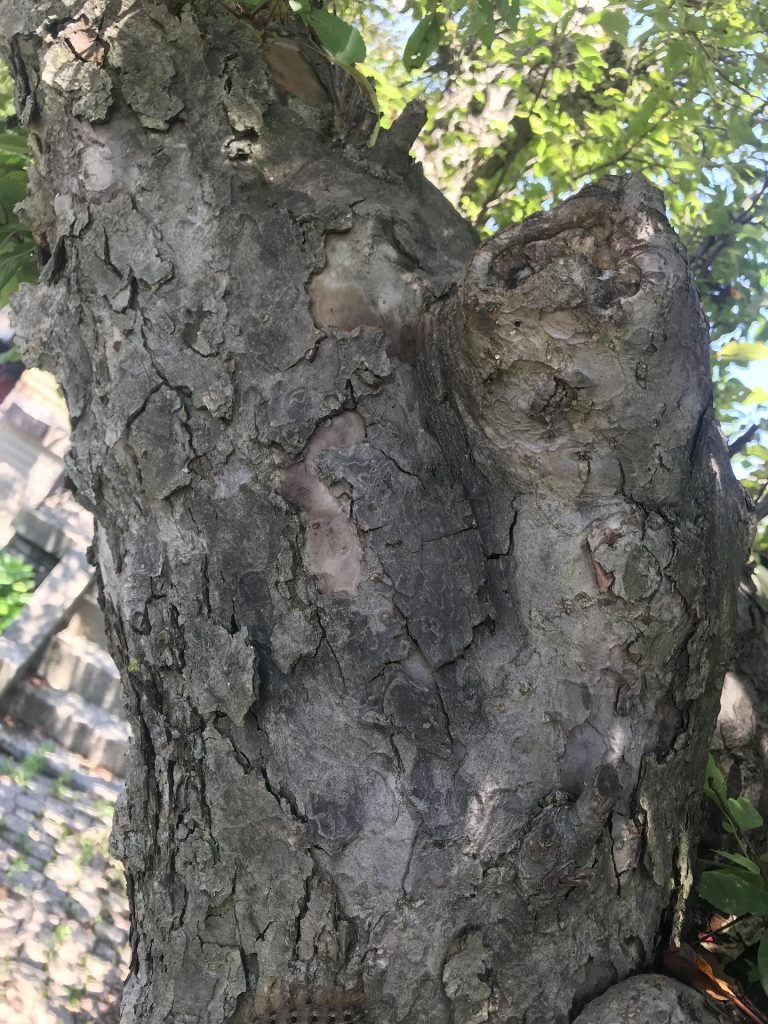
The bark of my crabapple tree seems to be dropping off – should I be concerned? It is a mature tree freestanding on my front lawn (south exposure)
Thank you for contacting Toronto Master Gardeners and congratulations on recognizing this issue. Early recognition can help take corrective measures before a tree becomes a hazard or before it is necessary to remove it.
Here are some possibilities to consider:
Some crab-apples have bark that mottles or even peels with age and you mention your tree’s maturity. If you see bark under the peeling bark , then this peeling may simply be a natural process but if you see bare wood then we need to think about other causes. This is because, directly beneath the outer bark of a tree is the living tissue (the “cambium layer”) where new bark and wood cells are created, and where water and nutrients move between the canopy of the tree and its root system.
Are the leaves and branches doing well overall? Are you getting that beautiful flowering for which crab apples are cherished? You do not mention sickly looking symptoms like defoliation, dead branches, insects, sparse foliage, lesions, yellowing or browning leaves or oozing but do be alert to such symptoms as they may indicate bacterial or fungal diseases. Comparing your photo to the photos found by “googling” “crab-apple tree bark diseases” , shows no similarity ,though it is hard to be sure from photos so please have a look yourself.
Your mention of a south exposure suggests the possibility of sunscald. Southern Ontario winters, with their thaws, followed by immediate returns to deep freeze, can cause tree trunks to split. This type of bark-splitting is thought to result from very cold temperatures on sunny winter days and is often associated with southwest exposure. On bright sunny days, the southwest side of the tree heats up, absorbing the heat of the sun. When the sun sets or goes behind a cloud, there is a sudden freezing of the warm tissue and the water in it. This “sun scald” results in the death of the exposed bark. The result is a vertical fissure down the center of the tree trunk, causing strips of bark to peel off, exposing the tree’s inner wood.
If the cambium is severely damaged, then the tree is vulnerable to stress, pests, and diseases so we would look for birds looking for insects in the crack or tear of the bark. Do you see any holes in the bark? Beetles bore holes in the bark to the cambium layer and lay eggs. Then other wildlife looking for them, may peel and damage the bark further. Do you have deer, or have you noticed squirrels pulling at the bark? Any wound can become an entry point for diseases, insects or decay .
Damage from sunscald may eventually heal(bark may not grow back but an otherwise healthy tree may form “wound wood” , essentially a callus that forms around the wound edges to prevent further injury or disease ). Encourage health by fertilizing in spring , if needed, proper pruning , giving adequate irrigation in hot, dry weather . Do not fertilize in the fall as that encourages new growth which is more susceptible to splitting . Do not remove the bark around the crack or paint or treat it .
Given the value that trees add to our properties and the consequences of not maintaining damaged trees, you may wish to consult with a certified arborist. The Ontario chapter of the International Society of Arboriculture’s website is where we usually direct people to help you to locate a qualified arborist in your area: https://www.isaontario.com/ but when I checked the site , I found that their ‘Find an Arborist’ “ icon also says ‘Coming Soon ‘. Landscape Ontario offers names of select arborists at https://landscapeontario.com/search. Referrals from neighbours or other tree lovers could be another great source.
Thank you for contacting us and thank you for noticing and caring about your tree.

